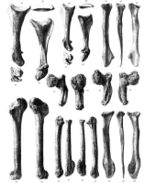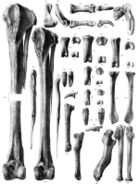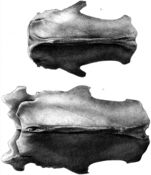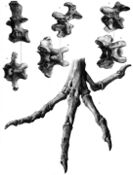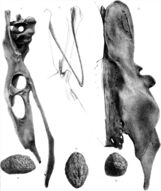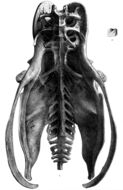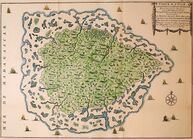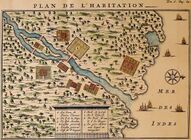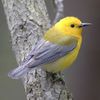ناسك رودريغيس
| Rodrigues solitaire | |
|---|---|

| |
| 1708 drawing by François Leguat, the only known illustration of this species by someone who observed it alive[1] | |
| التصنيف العلمي | |
| أصنوفة غير معروفة (أصلحها): | Pezophaps |
| Species: | †P. solitaria
|
| Binomial name | |
| †Pezophaps solitaria (Gmelin, 1789)
| |

| |
| Location of Rodrigues | |
| Synonyms | |
|
List
| |
ناسك رودريغيس : Rodrigues solitaire,
ناسك رودريغيس أو رودريغيس سوليتير (باللاتينية: Pezophaps solitaria) هو طائر منقرض غير قادر على الطيران كان يتوطن جزيرة رودريغيس الواقعة شرق جزيرة مدغشقر في المحيط الهندي، جينياً كان يعتبر من فصيلة الحماميات وأقرب طائر له هو طائر الدودو المنقرض أيضاً الذي كان يتواجد في جزيرة موريشيوس، يشكل الاثنان الفرع الحيوي المسمى الرافينيات. ويعتبر حمام نيكوبار الطائر الحي الأقرب لهما. تنمو طيور ناسك رودريغيس لتصبح بحجم الإوز العراقي، كما تتميز بمثنوية الشكل الجنسية، إذ أن الذكور أكبر حجما من الإناث ويبلغ طولها حوالي 90 سنتمترا ويصل وزنها إلى حوالي 28 كيلوغراما، بينما يبلغ طول الإناث حوالي 70 سنتمترا ووزنها حوالي 17 كيلوغرام. كان ريشها بني ورمادي، وكان لون الأنثى أكثر شحابة من لون الذكر. كما كان لهذه الطيور لون أسود على شكل حزام أعلى منقارها المعقوف قليلا، أما عنقها وقدميها فكانتا طويلتين. وكانوا يعيشون بشكل كبير في حدود مناطقهم الخاصة، وتبيض بيضة واحدة يحتضنها الذكر والأنثى كلاهما، وقد كانت تتغذى على الفواكه والبذور.
لوحظت هذه الطيور لأول مرة في القرن السابع عشر، ووصفها المستكشف الفرنسي فرنسوا ليغو بشكل مفصل، وألذي كان حينها قائد لمجموعة من الهوغونوتيين الفرنسيين اللاجئين الذين آلت بهم السبل في جزيرة رودريغيس بين 1691 و1693 أثناء توجههم إلى جزيرة لا ريونيون. تم صيد هذه الطيور من قبل الحيوانات المجتاحة والبشر حتى انقرضت في أواخر القرن الثامن عشر. لم تساعد رسومات ليغو وكتاباته هو وبعض معاصريه على معرفة الطائر، إلى أن تم اكتشاف بعض العظام له في كهف في سنة 1789، ومن ثم اكتشفت آلاف العظام له بعد ذلك.
. . . . . . . . . . . . . . . . . . . . . . . . . . . . . . . . . . . . . . . . . . . . . . . . . . . . . . . . . . . . . . . . . . . . . . . . . . . . . . . . . . . . . . . . . . . . . . . . . . . . . . . . . . . . . . . . . . . . . . . . . . . . . . . . . . . . . . . . . . . . . . . . . . . . . . . . . . . . . . . . . . . . . . . .
التصنيف
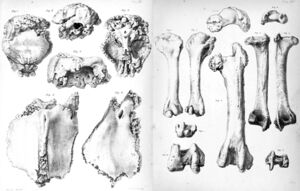
السلوك والبيئة
Diet
Tafforet's account confirms Leguat's description of reproductive behaviour, adding that Rodrigues solitaires would even attack humans approaching their chicks:
They do not fly at all, having no feathers to their wings, but they flap them, and make a great noise with their wings when angry, and the noise is something like thunder in the distance. They only ly, as I am led to suppose, but once in the year, and only one egg. Not that I have seen their eggs, for I have not been able to discover where they lay. But I have never seen but one little one alone with them, and, if any one tried to approach it, they would bite him very severely. These birds live on seeds and leaves of trees, which they pick up on the ground. They have a gizzard larger than the fist, and what is surprising is that there is found in it a stone of the size of a henn's egg, of oval shape, a little flattened, although this animal cannot swallow anything larger than a small cherry-stone. I have eaten them: they are tolerably well tasted.[3]
The size difference between sexes has led to the suggestion that the Rodrigues solitaire was not monogamous as stated by Leguat, and that this deeply religious man attributed the trait to the bird for moral reasons.[4] It has been proposed that it was instead polygynous, and the wing-rattling behaviour described for males suggests lek-mating, where males gather for competitive mating display.[5] However, size dimorphism does occur in some monogamous birds; most other pigeons are monogamous as well.[6] A 2015 article proposed that males invited females into their territories as secondary mates, which would result in the resident female acting aggressively towards the newcomer. Similar behaviour is seen in species that practice resource-defence polygyny. The territories probably provided all the food the birds needed in addition to acting as breeding-areas, and there was probably intense competition for favourable territories. The fact that Rodrigues island shrank by 90% at the end of the Pleistocene may also have contributed to such competition over territories, and thereby furthered sexual dimorphism.[7]
Relationship with humans
The Dutch viceadmiral Hans Hendricksz Bouwer was the first to list "dodos", most likely referring to the Rodrigues solitaire, as part of the fauna of Rodrigues in 1601.[8] The English traveller Sir Thomas Herbert mentioned "dodos" on Rodrigues again in 1634, and they were also mentioned in 1700.[9] The next account, which was the first referring to the bird as the "solitaire", was published in François Leguat's 1708 memoir, A New Voyage to the East Indies.[10] Leguat was the leader of a group of nine French Huguenot refugees, who were the first to colonise the island from 1691 to 1693, after they were marooned there by their captain. His description of the Rodrigues solitaire and its behaviour is the most detailed account of the bird in life, and he also described other species that are now extinct. Leguat's observations are considered some of the first cohesive accounts of animal behaviour in the wild. He later left for Mauritius, but was too late to observe dodos there.[11]
The Huguenots praised the Rodrigues solitaires for their flavour, especially that of the young, and used their gizzard stones as knife sharpeners. D'Héguerty later claimed these were also useful in medicine, and referred to them as bezoars.[11] The second most detailed description of the bird was found in an anonymous document rediscovered in 1874 called Relation de l'Ile Rodrigue, which has been attributed to Julien Tafforet, a mariner marooned on Rodrigues in 1726. His observations are considered credible, though it is known he had a copy of Leguat's memoirs with him during his stay.[1]

Many old accounts mention that Rodrigues solitaires were hunted by man. The Danish zoologist Japetus Steenstrup noted that some Rodrigues solitaire remains bore traces of having been broken by man or perhaps another large predator, to extract bone marrow.[4] Writing in 1735, the French lieutenant Gennes de la Chancelière described the capture and consumption of two specimens as follows:
Our men told of having seen goats and a large quantity of birds of different kinds: they brought, amongst others, two of which were bigger by a third than the largest turkey; they appeared, nevertheless to be still quite young, still having down on the neck and head; their wingtips were but sparsely feathered, without any proper tail. Three sailors told me of having seen two others, of the same species, as big as the biggest ostrich. The young ones that were brought had the head made more or less like the latter animal, but their feet were similar to those of turkeys, instead of that of the ostrich which is forked and cloven in the shape of a hind's foot. These two birds, when skinned, had an inch of fat on the body. One was made into a pie, which turned out to be so tough that it was uneatable.[11]
Unlike the dodo, no Rodrigues solitaires are known to have been sent to Europe alive. However, it has been claimed that the French naval officer Bertrand-François Mahé de La Bourdonnais sent a "solitaire" to France from the nearby island of Réunion around 1740. Since the Réunion solitaire is believed to have become extinct by this date, the bird may actually have been a Rodrigues solitaire.[12]
الانقراض
The Rodrigues solitaire probably became extinct sometime between the 1730s and 1760s; the exact date is unknown. Its disappearance coincided with the tortoise trade between 1730 and 1750; traders burnt off vegetation, hunted solitaires and imported cats and pigs that preyed on eggs and chicks.[12] In 1755, the French engineer Joseph-François Charpentier de Cossigny attempted to obtain a live specimen, as he had been assured the Rodrigues solitaire still survived in remote areas of the island. Though trying for 18 months, and offering large rewards, none could be found. He noted that cats were blamed for decimating the species, but suspected that it was due to hunting by humans instead.[12] The French astronomer Alexandre Guy Pingré did not encounter any solitaires when he visited Rodrigues to observe the 1761 transit of Venus, although he had been assured they survived. His friend, the French astronomer Pierre Charles Le Monnier named the constellation Turdus Solitarius after the bird to commemorate the journey. Although the Rodrigues solitaire is the only extinct bird to have a former constellation named for it, celestial mapmakers did not know what it looked like and star maps depicted other birds.[9]
By the time the discovery of subfossil Rodrigues solitaire bones from 1786 onwards confirmed Leguat's descriptions, no living residents of Rodrigues remembered having seen live specimens. In 1831, a man who had lived on Rodrigues for 40 years said that he had never seen birds large enough to be Rodrigues solitaires. Rodrigues covers only 104 square kilometres (40 sq mi), making it implausible that the bird would have survived undetected.[13]
. . . . . . . . . . . . . . . . . . . . . . . . . . . . . . . . . . . . . . . . . . . . . . . . . . . . . . . . . . . . . . . . . . . . . . . . . . . . . . . . . . . . . . . . . . . . . . . . . . . . . . . . . . . . . . . . . . . . . . . . . . . . . . . . . . . . . . . . . . . . . . . . . . . . . . . . . . . . . . . . . . . . . . . .
References
- ^ أ ب خطأ استشهاد: وسم
<ref>غير صحيح؛ لا نص تم توفيره للمراجع المسماةHumeSteel2013 - ^ BirdLife International (2012). "Pezophaps solitaria". IUCN Red List of Threatened Species. 2012. Retrieved 26 November 2013.
- ^ خطأ استشهاد: وسم
<ref>غير صحيح؛ لا نص تم توفيره للمراجع المسماةRothschild1907p177 - ^ أ ب خطأ استشهاد: وسم
<ref>غير صحيح؛ لا نص تم توفيره للمراجع المسماةNewtonClark1879 - ^ Livezey, B. C. (1993). "An Ecomorphological Review of the Dodo (Raphus cucullatus) and Solitaire (Pezophaps solitaria), Flightless Columbiformes of the Mascarene Islands". Journal of Zoology. 230 (2): 247–292. doi:10.1111/j.1469-7998.1993.tb02686.x.
- ^ خطأ استشهاد: وسم
<ref>غير صحيح؛ لا نص تم توفيره للمراجع المسماةHumeWalters2012p137 - ^ Byrkjedal, Ingvar; Grønstøl, Gaute; Lislevand, Terje (January 2016). "Possible resource-defence polygyny in the extinct Rodrigues Solitaire Pezophaps solitaria (Columbidae: Raphini". Ibis. 158 (1): 199–201. doi:10.1111/ibi.12329. قالب:Free access
- ^ Hume, J. P. (2003). "The journal of the flagship Gelderland – dodo and other birds on Mauritius 1601" (PDF). Archives of Natural History. 30 (1): 13–27. doi:10.3366/anh.2003.30.1.13.
- ^ أ ب خطأ استشهاد: وسم
<ref>غير صحيح؛ لا نص تم توفيره للمراجع المسماةFuller2002 - ^ Leguat, F. (1708). Voyages et Avantures de François Leguat & de ses Compagnons, en Deux Isles Desertes des Indes Orientales, etc (2nd ed.). Amsterdam: Jean Louis de Lorme. p. 77.
- ^ أ ب ت خطأ استشهاد: وسم
<ref>غير صحيح؛ لا نص تم توفيره للمراجع المسماةChekeHume2008p167 - ^ أ ب ت خطأ استشهاد: وسم
<ref>غير صحيح؛ لا نص تم توفيره للمراجع المسماةChekeHume2008p111 - ^ خطأ استشهاد: وسم
<ref>غير صحيح؛ لا نص تم توفيره للمراجع المسماةFuller2001
External links
 Media related to Pezophaps solitaria at Wikimedia Commons
Media related to Pezophaps solitaria at Wikimedia Commons Information related to Pezophaps solitaria from Wikispecies.
Information related to Pezophaps solitaria from Wikispecies.
- Cite iucn maint
- Short description is different from Wikidata
- Use British English from July 2012
- IUCN Red List extinct species
- Automatic taxobox cleanup
- Pages using multiple image with auto scaled images
- Extinct birds of Indian Ocean islands
- Extinct flightless birds
- Fauna of Rodrigues
- Raphinae
- Bird extinctions since 1500
- Birds described in 1789
- Taxa named by Johann Friedrich Gmelin

